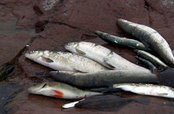Press release 2011-05-27 at 12:00
Evira, Finnish Environment Institute, National Institute for Health and Welfare, Finnish Game and Fisheries Research Institute
|
|

|
|
Photo: Riku Lumiaro
|
The EU Fish II project confirmed that many Baltic Sea fish remain safe to eat at least twice a week: perch, pike-perch, vendace, burbot, pike, whitefish, cod, sprat and roach. Lake fish and farmed fish contain even smaller concentrations of the hazardous substances studied.
The Finnish Food Safety Authority Evira recommends that municipalities inform consumers if the reduction of the consumption of a specific fish species is advisable on the basis of local results. In such a case, fish consumption should be reduced in line with official guidelines.
The research results provide a good overview of the current state of Finnish coastal areas of the Baltic Sea. They also serve the future implementation of the Baltic Sea Strategy. In fish, concentrations of dioxins, PCBs and particularly PBDEs, PFOSs and OT compounds are good indicators of regional contamination, for instance in harbours or river catchment areas. Although PFOS and OT compound concentrations in fish muscle were small, contamination could be detected using concentrations of hazardous substances in fish liver as an indicator.
Finnish Food Safety Authority Evira and other research institutes (National Institute for Health and Welfare THL, the Finnish Game and Fisheries Research Institute RKTL, the Finnish Environment Institute SYKE) have jointly carried out an extensive study in Finland, on the major organic pollutants in Baltic fish. Fish samples were collected from professional fishing catches in key fishing spots in the Oulu, Vaasa, Pori, Turku, Hanko and Kotka areas, and selectively from the lake district and farmed fish.
In 2009–2011, fish samples were analysed for dioxins and PCB compounds, as well as polybrominated diphenyl ethers (PBDE compounds) used in fire retardants. In addition, hazardous substances subject to little analysis until now, hydrophobic-lipophobic perfluorinated compounds (PFCs) and organic tin compounds (OT compounds), were investigated.
Similarly to an earlier study (2002–2003), the EU Fish II project analysis found higher concentrations of dioxins and PCBs in fish in the Gulf of Bothnia and Bothnian Bay than in the Gulf of Finland. Among individual herring less than 17 cm in length in the Bay of Bothnia, 6.5% exceeded the maximum concentration limit set by the EU. For herring more than 17 cm in length, the corresponding figure was 63%. Based on hazardous substance concentrations found in fish, Pori, Turku and Kotka stood out. In Kotka, higher concentrations were also found in large-sized flounder and bream, compared to concentrations in the same fish species in the Hanko area.
The Vanhankaupunginlahti Bay, a recreational area in the city of Helsinki, was the most contaminated area. Very high concentrations of both OT compounds and PFCs were found in perch and pike-perch. Concentrations of PBDE, PFOS and OT compounds in fish caught in the open Baltic Sea were small, equalling the level found in studies conducted in the southern Baltic Sea.
More information
Anja Hallikainen, Research Professor, Evira, tel. +358 50 386 8433
Hannu Kiviranta, Head of Chemical Exposure Unit, National Institute for Health and Welfare, tel. +358 40 541 1958
Riikka Airaksinen, Researcher, National Institute for Health and Welfare, tel. +358 20 610 6339
Pekka Vuorinen, Senior Research Scientist, Finnish Game and Fisheries Research Institute, tel. +358 40 732 7357
Jaakko Mannio, Senior Researcher, Finnish Environment Institute, tel. +358 400 148 604